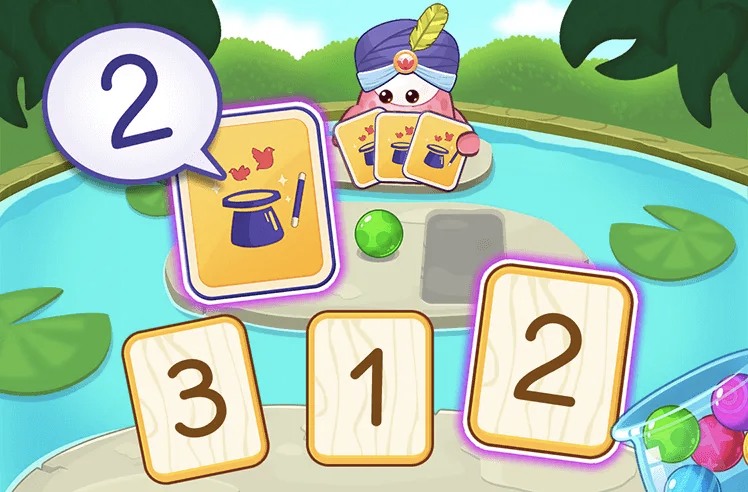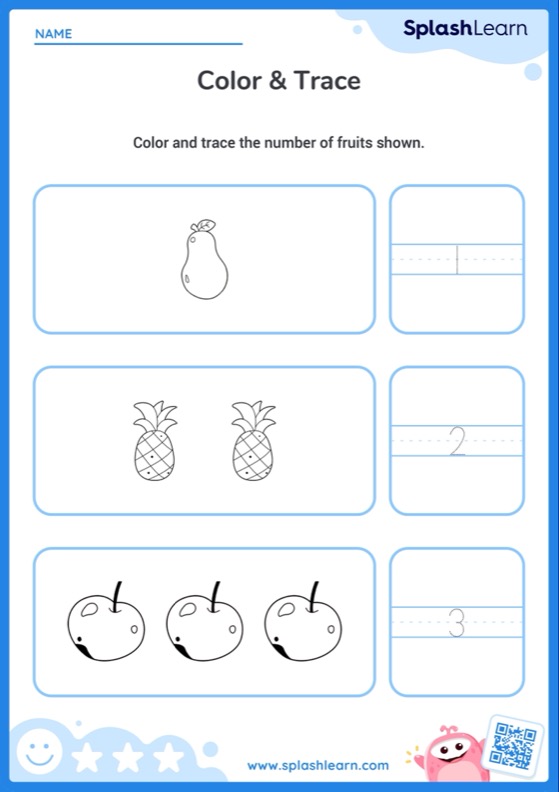Number recognition is crucial for early childhood development. Recognizing numbers forms the foundation for math skills children use throughout their lives. This guide will show you how to teach number recognition with simple, practical steps. Follow these easy methods to help your child recognize and understand numbers effectively.
Math & ELA | PreK To Grade 5
Kids see fun.
You see real learning outcomes.
Watch your kids fall in love with math & reading through our scientifically designed curriculum.
Parents, try for free Teachers, use for free
How to Teach Number Recognition to Kids
Step 1: Counting Aloud
Counting aloud helps children learn the sequence of numbers and how they sound. It’s a simple and effective way to start teaching number recognition.
When to start: Start counting aloud with your child as early as 2. Children are ready to start understanding and imitating sounds and sequences at this age.
How to do it:
- Count aloud: The best way to teach number recognition is by starting to count from 1 to 10 with your child. Make it a fun activity by playing count-aloud games and using different voices or clapping hands.
Begin with these count-aloud activities:
- Count everyday objects: Encourage your child to count objects around the house, like toys, fruits, steps or play interactive counting object games to keep them engaged.
- Songs and rhymes
Use counting songs and rhymes to make learning enjoyable. Songs like “One, Two, Buckle My Shoe” are great for this.
After this step, your child should be able to:
- Your child can count aloud from 1 to 10 without skipping any numbers.
- Your child can accurately count everyday objects, understanding that each number corresponds to one item.
Related Reading: Best Counting Activities for Preschoolers
Step 2: Recognizing Number Symbols
Recognizing number symbols helps children understand what numbers look like.
When to start: Begin introducing number symbols when your child is comfortable counting aloud, usually around age 3.
How to do It:
- Number Matching Games: Play simple games where your child matches objects to the correct number symbol.
Begin here:
- Flashcards: Use flashcards with numbers from 1 to 10. Show them one at a time and say the number out loud.
- Posters and Number Books: Hang posters with numbers in your child’s room or use number books during reading. Point to the numbers and name them.
After this step, your child should be able to:
- Your child can identify and name numbers from 1 to 10 when they see them.
- Your child can match number symbols with corresponding quantities.
- Your child consistently recognizes number symbols in different contexts, like books and posters.
Step 3: Matching Numbers to Quantities
Matching numbers to quantities helps children understand that each number represents a specific amount. This step reinforces the connection between numerical symbols and real-world objects.
When to start: Begin this step when your child can recognize numbers from 1 to 10, usually around age 3 to 4.
How to do it:
- Counting Objects: Show a number, like 3, and ask your child to count out 3 blocks or other small objects.
Begin with these number-matching games:
- Sorting Games: Use different objects. Ask your child to sort them into groups and then match the groups to the correct number.
- Visual Aids: Use pictures with objects and numbers. For example, a picture of 5 apples next to the number 5. Have your child count the apples and match them to the number.
After this step, your child should be able to:
- Count Out Objects: Your child can count out the correct number of objects to match a given number.
- Understand Quantity: Your child understands that the number symbol represents a specific quantity.
- Consistently Match: Your child consistently matches numbers to quantities in different activities and contexts.
Step 4: Writing Numbers
Writing numbers helps children reinforce their understanding of number symbols and develop fine motor skills. This step is essential for teaching number recognition through active engagement.
When to start: Begin teaching your child to write numbers once they can recognize and match numbers to quantities, typically around age 4.
How to do it:
- Tracing Worksheets: Use number tracing worksheets where your child can trace over dotted lines to form numbers.
Here are some fun worksheets to get started:
- Tactile Methods: Let your child trace numbers in sand, with finger paint, or using clay to form numbers.
- Practice Writing: Provide plenty of paper and writing tools. Encourage your child to write numbers on their own after tracing.
After this step, your child should be able to:
- Trace Numbers: Your child can trace numbers from 1 to 10 accurately.
- Write Independently: Your child can write numbers from 1 to 10 without tracing.
- Fine Motor Skills: Your child’s hand coordination improves, making their number writing clearer and more consistent.
Related Reading: How to Teach Number Formation in 5 Easy Steps
Step 5: Identifying Numbers in Different Contexts
Identifying numbers in different contexts helps children recognize numbers in everyday situations, reinforcing their learning and making it more practical.
When to start: Start this step once your child can write numbers from 1 to 10, typically around age 4 to 5.
How to do it:
- Spotting Numbers: Encourage your child to spot numbers around the house, such as on clocks, books, or street signs. Make it a game by asking, “Can you find the number 5?”
- Number Scavenger Hunt: Create a scavenger hunt where your child finds and identifies numbers in different places, like on food packages or in the park.
- Everyday Situations: Incorporate number identification in daily routines, like reading page numbers in books or finding numbers on a calendar.
After this step, your child should be able to:
- Recognize Numbers: Your child can identify numbers from 1 to 10 in various contexts, like books, signs, and household items.
- Consistent Identification: Your child consistently recognizes numbers without hesitation, showing confidence in their number knowledge.
- Practical Application: Your child applies their number recognition skills in everyday activities, demonstrating practical understanding.
Step 6: Comparing Numbers
Comparing numbers teaches children to understand numerical relationships, such as ‘more than,’ ‘less than,’ and ‘equal to.’ This step is crucial for developing basic math concepts.
When to start:
Begin this step once your child can identify numbers in different contexts, usually around age 5.
How to do it:
- Visual Aids: Use number lines or groups of objects to show differences between numbers. For example, use a number line to show that 5 is more than 3.
- Comparison Games: Play games where your child compares groups of objects. Ask questions like, “Which group has more blocks?” or “Which number is less?”
Begin with these fun activities:
- Interactive Activities: Use cards with numbers and ask your child to arrange them from the smallest to the largest, or vice versa.
After this step, your child should be able to:
- Understand Comparisons: Your child can compare two numbers and identify which is more, less, or if they are equal.
- Use Concepts: Your child uses the concepts of ‘more than,’ ‘less than,’ and ‘equal to’ accurately in different scenarios.
- Visual Representation: Your child can use visual aids, like number lines or object groups, to explain their comparisons.
Step 7: Sequencing Numbers
Sequencing numbers involves arranging numbers in the correct order, both forwards and backwards. This step helps children understand the numerical order and strengthens their counting skills.
When to start:
Begin this step once your child can compare numbers, typically around age 5 to 6.
How to do it:
- Number Cards: Use number cards from 1 to 10. Mix them up and ask your child to arrange them in the correct order.
- Counting Forwards and Backwards: Practice counting forwards and backwards aloud. For example, count from 1 to 10, then from 10 back to 1.
Start with these fun counting games:
- Number Puzzles: Provide puzzles where your child must place numbers in the correct sequence to complete the picture or pattern.
Here are some fun number puzzle games:
After this step, your child should be able to:
- Correct Sequencing: Your child can arrange numbers from 1 to 10 in the correct order.
- Counting Backwards: Your child can count backwards from 10 to 1 accurately.
- Confidence in Sequencing: Your child confidently sequences numbers in various activities and games.
Step 8: Recognizing Number Patterns
Recognizing number patterns involves identifying and continuing sequences, such as counting by twos or fives. This step enhances pattern recognition and prepares children for more advanced math skills.
When to start: Begin once your child can sequence numbers correctly, typically around age 6.
How to do It:
- Counting by Twos and Fives: Teach your child to count by twos (2, 4, 6, 8, 10) and fives (5, 10, 15, 20). Use a number chart to help visualize these patterns.
Get started with this fun activity:
- Pattern Games: Play games where your child identifies and continues number patterns. For example, start a sequence like 2, 4, 6, and ask your child what comes next.
- Interactive Activities: Use objects like beads or blocks to create physical patterns. Ask your child to continue the pattern you start.
After this step, your child should be able to:
- Recognizing Patterns: Your child can identify simple number patterns, such as counting by twos or fives.
- Continuing Sequences: Your child can continue a given number pattern accurately.
- Applying Patterns: Your child uses pattern recognition skills in various activities and can explain how they identified the pattern.
Conclusion
Recognizing numbers is a vital skill that lays the foundation for future math success. These simple steps on how to teach number recognition make learning easy and fun for your child.
Related Reading: How to Teach Place Value in 9 Easy Steps
Frequently Asked Questions (FAQs)
What is number recognition?
Number recognition is the ability to identify and name numbers when seen. It involves recognizing the symbols for numbers and understanding their meaning.
At what age should a child recognize numbers?
Most children start recognizing numbers between ages 3 and 4, although this can vary depending on individual development.
What are the skills of number recognition?
Skills of number recognition include identifying number symbols, matching numbers to quantities, writing numbers, and recognizing numbers in different contexts.
How do most children develop number sense?
Most children develop number sense through activities that involve counting, comparing numbers, sequencing, and recognizing patterns, often supported by playful and engaging learning methods.
















































